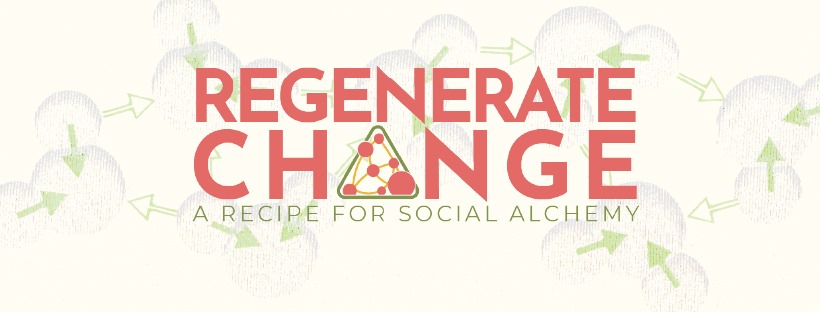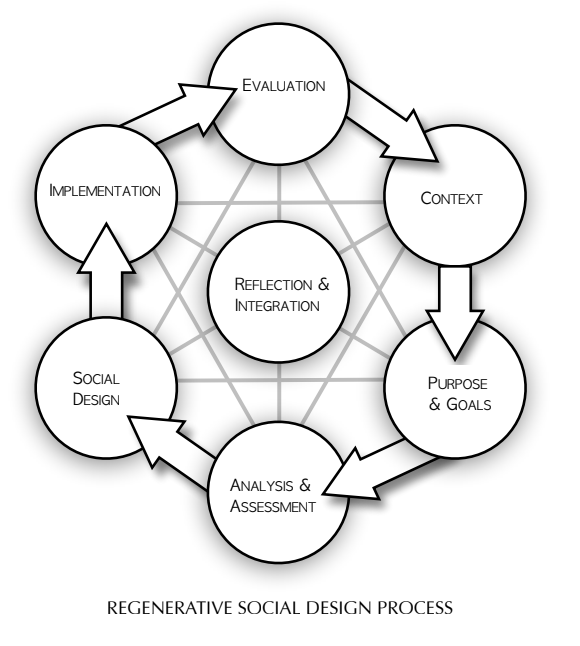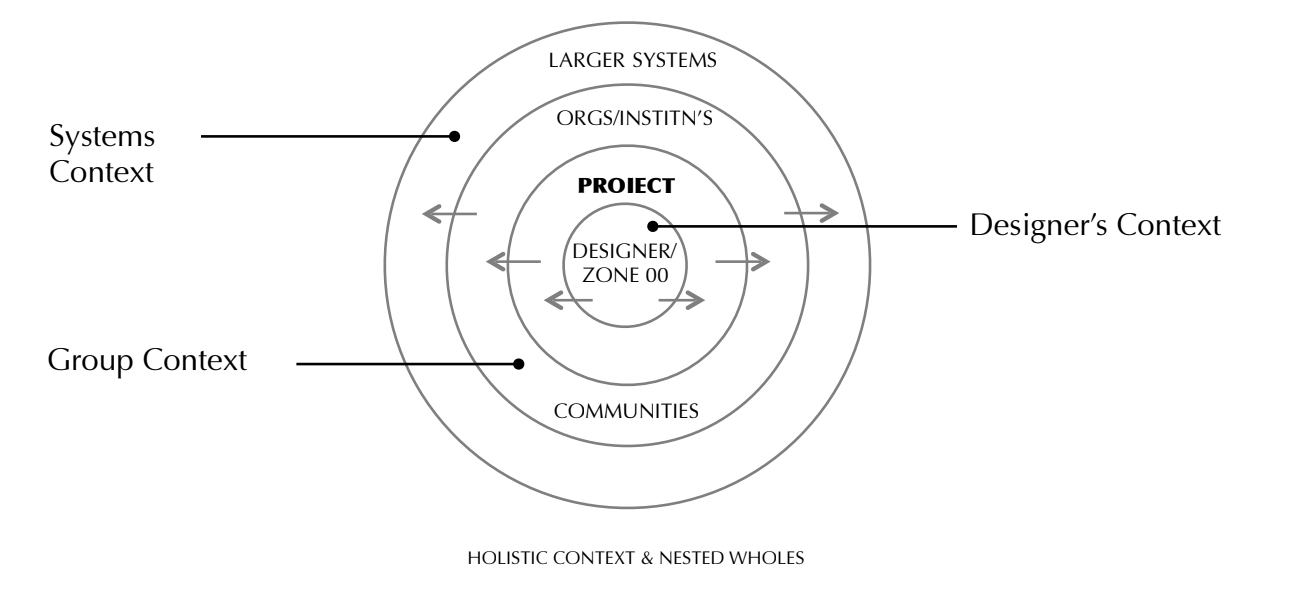
Image via Regenerate Change Facebook Page
Over the weekend of April 22nd-23rd, Abrah Dresdale of Regenerate Change led Bard students, staff, and surrounding community members in their training “Regenerative Design for Changemakers.” Participants designed a changemaking project of their choosing, ranging from homestead building to curriculum design to the creation of safe spaces on campus, during the social design lab portion of the training.
Abrah defines Regenerative Design as “applying the intelligence of nature to shaping societal systems big and small.” This approach includes whole systems design thinking, a regenerative paradigm (as shifted from exploitation paradigms), the healing of personal and societal trauma, and ecological principles paired with a social justice approach.
In times of urgent issues such as climate change, mass incarceration, and public health crises, Abrah asks, “why do we slow down to design instead of moving straight into action?” and provides examples of the necessity of intervening in systems thoughtfully so that we may engage with change intentionally rather than following reactive impulse. We need time to have freedom to engage creativity and contextual conditions and to consider and weigh multiple possibilities. This is one primary expression of liberation.
Abrah reminds us that the gift of “the weekend” apart from the work week comes from Islamic, Jewish, and Christian practices of the sabbath, and was implemented by labor unions. This cultural invention is one example of slowing down to reflect and integrate, then take action with more intention. Space for imagination allows us to design outside of what we are taught is possible.
We are all designers:
We all go through design processes on a daily basis, with everything from choosing an outfit to crafting a social or work event. By making our inherent design processes explicit and conscious rather than implicit and subconscious, we come from a place of power to create and continuously evaluate and re-evaluate our thinking.
The process as described by Regenerate Change in their programming, and in Abrah’s book “Regenerative Design for Changemakers,” is as follows, with examples pertaining to Abrah’s collaborative experience of the creation of the Jail-to-Farm-to-College & Employment program in Massachusetts’ Franklin County Jail.

IMAGE FROM FORTHCOMING REGENERATIVE DESIGN FOR CHANGE MAKERS GUIDEBOOK ©
BY ABRAH JORDAN DRESDALE, MA
Context: Locate your project in physical, political, and social contexts. What are the key social and ecological conditions or patterns that surround your project? The context generally includes the “4 P’s,” including People, Place, Power, and Paradigm.
- Example: In Abrah’s project of the creation of Jail-to-Farm-to-College & Employment program in Massachusetts’ Franklin County Jail, there were approximately 250 people in a medium security jail in Greenfield, MA, stripped of personal sovereignty and voice, within the sociopolitical paradigm of mass incarceration.
 IMAGE FROM FORTHCOMING REGENERATIVE DESIGN FOR CHANGE MAKERS GUIDEBOOK © BY ABRAH JORDAN DRESDALE, MA
IMAGE FROM FORTHCOMING REGENERATIVE DESIGN FOR CHANGE MAKERS GUIDEBOOK © BY ABRAH JORDAN DRESDALE, MA
Purpose & Goals: What are the big ideas underlying your project? What do you aim to shift, ecologically, socially, and/or culturally? What will come about as a result of your design intervention/solution?
- Example: In the Franklin County Jail, the purpose of the garden project was to create conditions for sovereignty and dignity through the vehicles of gardening, farming, and higher education, which also provides, on the way, increased nutrition, therapeutic opportunities, skill trainings, and a supportive network and community of mentors, practitioners, and resources.
Analysis & Assessment: observations of the context interpreted – why does it matter? Identify key players in the social ecosystem, including beneficiaries (who benefit from the project/who it is designed for in some way), key stakeholders, accomplices (people helping those leading the project), adversaries, champions, and gatekeepers. What are the dynamics between key players?
- Example: Within systems of incarceration, non-incarcerated individuals hold continued power, in voice and access to resources, over incarcerated individuals. Complex hierarchies exist within jails, with correctional officers, administrators, and volunteers all playing roles in institutional dynamics.
Social Design: The design stage is ultimately a marriage between analysis and goals. When designing, we act as midwives, who ultimately step back and help natural processes and solutions take form. We build design directions with observations and interpretations. We ask: “Now what?” to move us toward solutions. Does what we are designing reinforce or disrupt existing systems of power and related paradigms? Has the “problem” been determined by beneficiaries or those who hold power?
- Example: Through the design of the Jail-to-Farm-to-College & Employment program, designers developed an integrated pathway linking incarcerated men with therapeutic, skills-building, and employment opportunities through land and farm work, through which college course credit could be earned through Greenfield Community College.
Implementation: As the project begins, continue re-evaluating and asking: Do I have the capacity to implement this program alone? Who can be on my team? What structures can we design for mutual accountability and clear lines of communication? What resources are available, and what resources are needed?
Evaluation: During the continued process of (re) evaluation, ask: What is my aim in evaluating the project? What are the process, outcomes, impacts, and/or benchmarks I want to measure? Am I the evaluator? Or are participants/beneficiaries the evaluators?
- Example: Participants currently experiencing incarceration design rubrics, deliver peer-to-peer evaluations, and provide input to refine the program that they learn within.
Reflection & Integration: What did I learn? Take stock before starting anew.
- Examples: Lessons learned reveal themselves when we slow down to integrate our experience with the design process.Reflect on personal and team progress with team debriefs, unplugging and meditating, and year in review rituals.
More resources from Abrah Dresdale and Regenerate Change:
CONNECT:
- Websites: Check out Abrah Dresdale’s website & the Regenerate Change website
- Instagram: Follow us at @RegenerateChange
- Newsletter: Sign up for the Regenerate Change newsletter, sent each new moon and some full moons! (Check out one of our past newsletters)
- Online Network: Join Regenerative Changemakers, a socially conscious educational and networking platform, where Regenerate Change courses, frameworks, and events are posted
LEARN:
- Learn with Abrah: Register for one of the other upcoming courses she teaches
- Online Regenerative Design for Changemakers 7 week Course: Check out course details of the companion course to her book!
- Resource Library: Visit the Regenerate Change Free Resource Library and download samples of regenerative educational resources
- Sector Analysis Handout: Download a digital version of the project sector exercise we work with at book launch parties!
- Check out Recording: Virtual Book Launch Party, hosted by UMASS Libraries–learn about the book and how it came to be; watch it HERE
READ:
- Free Chapter: Download Chapter 8 of Abrah’s book ahead of time or share with friends and colleagues: Context–Identifying the Problems & Possibilities
- Read related Regenerate Change publications: Visit our Virtual Bookshop

Reply